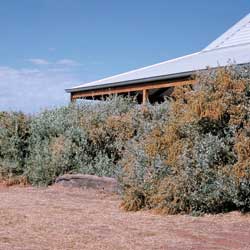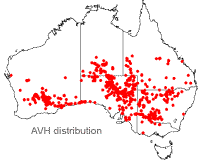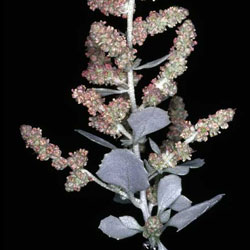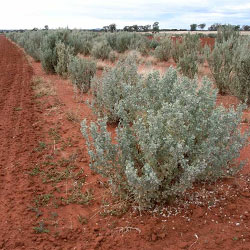Atriplex nummularia
 |
Old Man Saltbush
Atriplex nummularia, commonly called Old Man Saltbush, is a member of the saltbush family, Chenopodiaceae. There are over 250 species in the Atriplex genus, mostly in sub-tropical and temperate regions of the world. About 61 species occur in Australia.  A. nummularia is widespread in the inland semi-arid and arid regions of mainland Australia. It is usually, but not always, found on saline, clay soils in low lying areas like flood plains. However, it is very adaptable and can occur on most soils.
A. nummularia is widespread in the inland semi-arid and arid regions of mainland Australia. It is usually, but not always, found on saline, clay soils in low lying areas like flood plains. However, it is very adaptable and can occur on most soils.
The largest of the Australian saltbushes A. nummularia can grow to 3m high and 2–4m wide. Its leaves, 1–3cm long, have a scaly coating which gives them an attractive silvery grey colour. The shape of the leaves may vary considerably from elliptical to almost circular, both on the same plant and in different populations of the species.
Throughout the year, A. nummularia produces very small flowers which are wind pollinated. Male and female flowers occur on separate plants. The female flowers are in dense clusters along panicles about 20 cm long and the male flowers are in disjunct globules at the ends of branches. After fertilisation, leafy bracts of the female flower become enlarged and surround the developing seed. These fruiting bracteoles are attached only at the base and are approximately 1cm wide in the shape of a fan.
A.nummularia can be propagated by cuttings or seed. Propagation by seed is usually done by sowing the fruiting bracteoles. Germination rates are increased by rubbing the fruits with the hands under running water for several minutes or soaking them in water for at least an hour. The fruits can then be sown directly into the soil or first placed into a Viro-cell for sowing. The best times to sow seed are in autumn, early winter and spring.
Alternatively, cuttings of A.nummularia can placed into a mixture of sand and potting mix, making sure that there is plenty of ventilation and that mist is avoided to prevent the development of a leaf spotting fungus.
In some areas, the red legged earth mite has been known to infest A.nummularia, causing malformation of new shoots. A.nummularia may also be attacked sporadically by a native saltbush scale which is normally controlled by natural enemies.
On the whole, A. nummularia is very adaptable and can tolerate severe droughts as well as periodic flooding. It is frost and salt tolerant. A. nummularia also recovers well after intense defoliation, making the plant very suitable for pruning. It will tolerate most soils but is best grown in a well drained position which is sunny for most of the day.
Atriplex nummularia is an extremely versatile plant that has frequently been used as a fodder plant for cattle and sheep and is often planted near property homesteads as a shelter. It provides a useful windbreak which, along with readily visible leaves at night, makes it suitable for roadside plantings. The ornamental foliage can be pruned to make hedges and provides an attractive silvery contrast against darker plants in the garden.
Text by Catherine Viney (2007 Botanical Intern)
Name Meaning: Atriplex nummulariaAtriplex — from the Latin atriplexum, meaning orache, a plant used as a substitute for spinach. nummularia — refers to the leaves resembling the circular shape of a coin, nummus. |
References
Bindon, P. 1996. Useful bush plants. Western Australian Museum, Perth.
Bonney, N. 2003. “What seed is that?” A guide to the identification, collection, germination and establishment of native plant species for central southern Australian landscapes. Revised edition. N. Bonney, Tantanoola, South Australia.
Carr, D. and Curtis, D. 2000. Plants in your pants II. A pocket guide to the trees and shrubs of the north west of NSW. Greening Australian Northwest, Armidale.
Cunningham, G., Mulham, W.E., Milthorpe, P.L. and Leigh, J.H. 1981 Plants of western New South Wales. Soil Conservation Service of NSW. NSW Government Printing Office.
Hall, N., Boden, R., Christian, C.S., Condon, R., Dale, F., Hart, A., Leigh, J., Marshall, J., McArthur, A., Russell, V. and Turnbull, J. 1972. The use of trees and shrubs in the dry country of Australia. Department of National Development Forestry and Timber Bureau, Australian Government Publishing Service, Canberra.
Jones, D. and Elliot, R. 1986. Pests diseases and ailments of Australian plants with suggestions for their control. Lothian Publishing Company Pty. Ltd., Melbourne.
Kutsche, F. and Lay, B. 2003. Field guide to the plants of outback South Australia. Department of Water, Land and Biodiversity Conservation. South Australia.
Mitchell, A.A. and Wilcox, D.G. 1994. Arid shrubland plants of Western Australia. Second edition. University of Western Australia Press, Nedlands.
Molyneux, B. and Forrester, S. 1993. The Austraflora guide to choosing and growing Australian plants. Kangaroo Press, Kenthurst NSW.
Urban, A. 1993 Wildflowers & plants of central Australia. Portside Editions Pty. Ltd., Fishermens Bend.
Wilson, P.G. 1984. Chenopodiaceae. In George, A.S. (ed.) Flora of Australia. Volume 4. Australian Government Publishing Service, Canberra.
Wrigley, J.W. and Fagg, M. 2003. Australian native plants. Cultivation, use in landscaping and Propagation. Fifth edition. Reed New Holland ( Australia) Pty. Ltd., Frenchs Forest.
![An Australian Government Initiative [logo]](/images/austgovt_brown_90px.gif)



